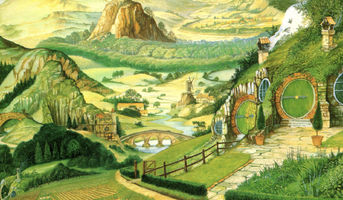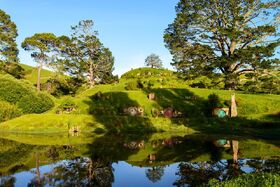Hobbiton was a village in the Westfarthing of the Shire.
History
Hobbiton was located in the center of the Shire in the far eastern part of the Westfarthing. It was the home of many illustrious Hobbits, including Bilbo and Frodo Baggins and Samwise Gamgee. Notable locations in Hobbiton included the Old Mill and Bag End. At the end of the War of the Ring, Saruman's treachery destroyed much of the Shire, and Hobbiton suffered greatly. The Old Mill had been replaced with a noxious factory-like structure, and many trees had been cut down.[1][2]

After the servants of Saruman had been expelled from the Shire, Sam Gamgee used magic soil from the garden of the Elf lady Galadriel to heal the Shire in whole, but with particular attention to Hobbiton.
In adaptations

For Peter Jackson's The Lord of the Rings film trilogy, Hobbiton was filmed on an originally bare stretch of farm-land in Matamata, New Zealand. Before Hobbit-holes, much greenery, and other set-pieces were installed, John Howe and Alan Lee spent time sketching how they would visualize Hobbiton, sitting on a hill looking over the land.[3] In the farm's long transformation, the crew built at least thirty distinct Hobbit-holes (excluding Bag End).[4] As per the contract with the farmer all the structures were temporary and were removed at the end of production.
In the decade following The Lord of the Rings films, the site became popular with tourists, such that when The Hobbit film trilogy came to be shot the structures were reconstructed in more permanent materials.

The Hobbiton set can still be visited in New Zealand. Many set-pieces from the films still remain and can be viewed and explored by tourists, such as the Hobbit-holes and The Green Dragon Inn.
Translations
| Foreign Language | Translated name |
| Amharic | ሖብቢቶን |
| Arabic | حوببيتون |
| Armenian | Հոբբիտոն |
| Assamese | হবিটন |
| Belarusian Cyrillic | Hоббітон |
| Bengali | হব্বিতন |
| Cambodian | ហូបូតុន |
| Catalan | Hòbbiton |
| Chinese (Hong Kong) | 哈比屯 |
| Czech | Hobitín |
| Danish | Hobbitrup |
| Dutch | Hobbitstee |
| Estonian | Kääbikla |
| Finnish | Hobittila |
| French | Hobbitebourg |
| Georgian | ჰობიტონი |
| German | Hobbingen |
| Gujarati | હોબબિટન |
| Hebrew | הוביטון |
| Hindi | हॉबिटॉन |
| Japanese | ホビットン |
| Kannada | ಹೊಬ್ಬಿಟೋನ್ |
| Kazakh | Һоббітон (Cyrillic) Hobbiton (Latin) |
| Korean | 호비튼 |
| Kyrgyz Cyrillic | Hоббитон |
| Laotian | ຮໂບບິຕໂນ |
| Macedonian Cyrillic | Хоббитон |
| Malayalam | ഹോബിഷന് |
| Marathi | हॉबबिटॉन |
| Mongolian Cyrillic | Hоббитон |
| Nepalese | होब्बितोन् |
| Norwegian | Hobbitun |
| Pashto | حوببیتون |
| Persian | حوببیتون |
| Portuguese (Brazil) | Vila dos Hobbits |
| Punjabi | ਹੌਬਿਟਨ |
| Russian | Хоббитон |
| Sanskrit | होब्बितोन् |
| Serbian | Хоббитон (Cyrillic) Hobiton (Latin) |
| Sinhalese | හොබිට්ටන් |
| Slovak | Hobitov |
| Slovenian | Hobitovo |
| Spanish (Spain and Latin America) | Hobbiton |
| Swedish | Hobsala/Hobbinge |
| Tajik Cyrillic | Ҳоббитон |
| Tamil | ஹோப்பிட்டான் |
| Telugu | హొబ్బితోం |
| Thai | ฮอบบิตัน |
| Turkish | Hobbitköy |
| Ukrainian Cyrillic | Гоббітон |
| Urdu | حوببیتون |
| Uzbek | Ҳоббитон (Cyrillic) Hobbiton (Latin) |
| Yiddish | האָבביטאָן |
References
- ↑ The Atlas of Middle-earth, Regional Maps, "The Shire"
- ↑ The Atlas of Middle-earth, The Lord of the Rings, "Hobbition and Bag End"
- ↑ Daniel Falconer, Middle-earth: From Script to Screen, pg. 18
- ↑ Daniel Falconer, Middle-earth - From Script to Screen, pgs. 24, 25
